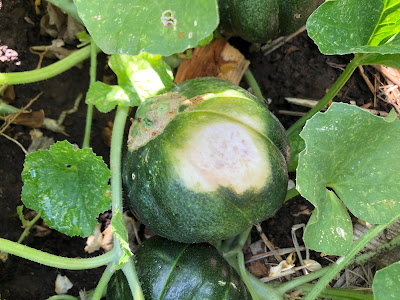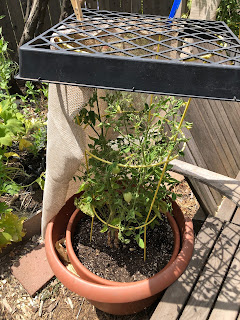
Quick help for plants in danger of sunburn
 |
|
Argh, this Noir Des Carmes melon became sunburned before I could
protect it. (Photos: Kathy Morrison) |
Venture outside in this heat without a hat and sunscreen, and you know what you'll get: Sunburned skin.
Pity your plants, which can't don sun-protective gear or move into the shade. Yet they get sunburned, too.
Sunscald mars ripening tomatoes and peppers. Even melons get scorched in intense heat.
Here's the deal: Growing something that requires "full sun" doesn't always mean, in our climate, "full exposure to sun." Full heat may require some filtered afternoon shade.
 |
| Lace tablecloths filter the sun in a community garden plot. |
The experienced gardeners in my community garden have learned this. Some grow tomatoes under a wooden superstructure that shades the plants. Others hang shade cloth or frost cloth across the front of their tomato plants. A few have a sea of lace tablecloths floating on stakes over their veggies, giving the garden a refined air.
Frankly, I've given up trying to grow bell peppers and certain tomato varieties in full sun. My Robeson tomato, which does not like intense heat, is doing quite nicely this year in a large pot on the north side of a backyard crape myrtle tree. The peppers are also in pots, cozying up against rose bushes and dwarf citrus trees, which give just enough shade.
Are you seeing sunscald on your developing produce? Here are 5 hacks you can try now with items in your home or garden. Since they're not permanent solutions, be sure to plan for 2020: It's going to be just as hot next year.
 |
|
A plant flat anchors some shade cloth on
this Burbank tomato in a pot.
|
1) Use black plastic plant flats balanced on top of tomato cages. They fit, I found out in desperation one summer. Use them alone or to anchor a piece of burlap or shade cloth to protect peppers or small tomato plants.
2) Put paper hats on melons. Use junk mail envelopes (plain ones, not the ones with the windows) as quick paper hats or cones over your most-exposed little melons. Or fold a piece of newspaper into a tent for a larger melon.
3) Newspaper sections also work as quick, desperation shade, hanging off tomato cages and cucumber trellises. Light can't get through it at all, however, so replace it soon with something less opaque.
4) Are the plants growing up a fence or trellis? Use clothes pins to attach thin dishtowels (worn ones work best) to the trellis, hanging them over the veggies. This is good for cucumbers or any other climbing vegetables.
5) Bring tree shade to the veggies: Trim off just a foot or so of a thin leaf-filled branch from an ornamental tree and lay it carefully among ground-growing veggies, such as squash or melons. The leaves will filter the sun just enough.
Comments
0 comments have been posted.Sacramento Digs Gardening to your inbox.
Sites We Like
Garden Checklist for week of May 12
Get your gardening chores and irrigation done early in the day before temperatures rise.
* Plant, plant, plant! It’s prime planting season in the Sacramento area. Time to set out those tomato transplants along with peppers and eggplants. Pinch off any flowers on new transplants to make them concentrate on establishing roots instead of setting premature fruit.
* Direct-seed melons, cucumbers, summer squash, corn, radishes, pumpkins and annual herbs such as basil.
* Harvest cabbage, lettuce, peas and green onions. This heat will cause leafy greens and onions to flower; pick them before they bolt.
* In the flower garden, direct-seed sunflowers, cosmos, salvia, zinnias, marigolds, celosia and asters.
* Plant dahlia tubers. Other perennials to set out include verbena, coreopsis, coneflower and astilbe.
* Transplant petunias, marigolds and perennial flowers such as astilbe, columbine, coneflowers, coreopsis, dahlias, rudbeckia and verbena.
* Keep an eye out for slugs, snails, earwigs and aphids that want to dine on tender new growth.
* Feed summer bloomers with a balanced fertilizer.
* For continued bloom, cut off spent flowers on roses as well as other flowering plants.
* Got fruit trees? If you haven't already done so, thin orchard fruit such as apples, peaches, pears, pluots and plums before they grow too heavy, breaking branches or even splitting the tree. Leave the largest fruit on the branch, culling the smaller ones, and allow for 5 to 6 inches (or a hand's worth) between each fruit.
* Thin grape bunches, again leaving about 6 inches between them. For the remaining bunches, prune off the "tail" end, about the bottom third of the bunch, so that the plant's energy is concentrated in the fruit closest to the branch.
* As spring-flowering shrubs finish blooming, give them a little pruning to shape them, removing old and dead wood. Lightly trim azaleas, fuchsias and marguerites for bushier plants.
* Add mulch to the garden to help keep that precious water from evaporating. Mulch also cuts down on weeds. But don’t let it mound around the stems or trunks of trees or shrubs. Leave about a 6-inch to 1-foot circle to avoid crown rot or other problems.